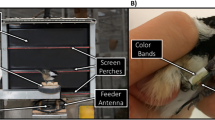Abstract
In the previous companion paper, the possibility of learning by Chasmagnathus in field conditions was demonstrated. Here, we study long-term memory inquiring to what extent an internal representation could be maintained in a complex environment. Two 45-min training sessions, each of 15 visual danger stimulus presentations with 3-min intertrials, were given at a 24-h interval. Throughout the first training session and during the first 22.5 min of re-training on day 2, crabs kept the same hiding response level but then, during the second phase of re-training, the re-emerging increased up to the point that 32% of surface crabs ignored the stimulus. Each session was followed by a 22.5-min testing without stimulation. At testing on day 2 after re-training, crabs showed a change in the usual exploring strategy. Results reveal long persistency in responding despite a rest interval of 24 h followed by a gradual decrease in response until it vanishes. The statistical analysis was performed by comparing performances at day 2 (Rescorla in Am Psychol 43:151–160, 1988) and then confirmed through comparisons between day 1 and day 2. However, it is not possible to identify separate and taxonomically well-defined learnings but rather a tangled collection of processes that influence each other blurring some of the diagnostic features of each learning.





Similar content being viewed by others
Abbreviations
- VDS:
-
Visual danger stimulus
- STG:
-
Short-term group
- LTG:
-
Long-term group
- s-VG:
-
Single-VDS group
- REL:
-
Re-emerging latency
References
Bouton M (1993) Context, time and memory retrieval in the interference paradigms of Pavlovian learning. Psychol Bull 114:80–99
Brunner D, Maldonado H (1988) Habituation in the crab Chasmagnathus granulatus: effect of morphine and naloxone. J Comp Physiol A 162:687–694
Collett TS, Collett M (2002) Memory use in insect visual navigation. Nat Rev Neurosci 3:542–552
Dudai Y (2002) Molecular bases of long-term memories: a question of persistence. Curr Opin Neurobiol 12:211–216
Fanselow M (2000) Contextual fear, gestalt memories, and the hippocampus. Behav Brain Res 110:73–81
Fathala MV, Iribarren L, Kunert C, Maldonado H (2009) A field model of learning: 1. Short-term memory in the crab Chasmagnathus granulatus. J Comp Physiol A
Jenkins HM, Moore BR (1973) The form of the autoshaped response with food or water reinforcers. J Exp Anal Behav 20:163–181
Kaczer L, Maldonado H (2009) Contrasting role of octopamine in appetitive and aversive learning in the crab Chasmagnathus. PLoS One 4:e6223
Liu L, Wolf R, Ernst R, Heisenberg M (1999) Context generalization in Drosophila visual learning requires the mushroom bodies. Nature 400:753–756
Lunney GH (1970) Using analysis of variance with dichotomous dependent variable: an empirical study. J Educ Meas 7:263–269
Maldonado H (2002) Crustacean as model to investigate memory illustrated by extensive behavioral and physiological studies in Chasmagnathus. In: Wiese K (ed) The crustacean nervous system. Springer, Berlin, pp 314–327
Menzel R (1999) Memory dynamics in the honeybee. J Comp Physiol A 185:323–340
Menzel R, Giurfa M (2006) Dimensions of cognition in an insect, the honeybee. Behav Cogn Neurosci Rev 5:24–40
Montarolo PG, Goelet P, Castellani VF, Morgan J, Kandel ER, Schachter S (1986) A critical period for macro-molecular synthesis in long-term heterosynaptic facilitation in Aplysia. Science 234:1249–1254
Pedreira ME, Romano A, Tomsic D, Lozada M, Maldonado H (1998) Massed and spaced training built up different components of long-term habituation in the crab Chasmagnathus. Anim Learn Behav 26:34–45
Peeke HVS (1988) Habituation and the maintenance of territorial boundaries. Academic Press, New York
Rescorla RA (1988) Pavlovian conditioning. It’s not what you think it is. Am Psychol 43:151–160
Rescorla R (2004) Spontaneous recovery. Learn Mem 11:501–509
Rescorla R, Holland PC (1976) Some behavioral approaches to the study of learning. In: Bennett E, Rosenzweig MR (eds) Neural mechanisms of learning and memory. MIT Press, Cambridge, pp 165–192
Skinner BF (1938) The behaviour of organisms. Appleton-Century-Crofts, New York
Tomsic D, Massoni V, Maldonado H (1993) Habituation to danger stimulus in two semiterrestrial crabs: ontogenic, ecological and opioids modulation correlates. J Comp Physiol A 173:621–633
Vergoz V, Roussel E, Sandoz JC, Giurfa M (2007) Aversive learning in honeybees revealed by the olfactory conditioning of the sting extension reflex. PLoS One 2:e288
Acknowledgments
We thank Iribarren L., Piriz G., Tedesco M., and Gomez V. for technical assistance in the field. This work was supported by FONCYT (Grant PICTR 00349, PICT-2006-02261), UBACYT (Grant X326), and CONICET (PIP 112-200801-02457 and PIP 2004-5466).
Author information
Authors and Affiliations
Corresponding author
Rights and permissions
About this article
Cite this article
Fathala, M.V., Kunert, M.C. & Maldonado, H. A field model of learning: 2. Long-term memory in the crab Chasmagnathus granulatus . J Comp Physiol A 196, 77–84 (2010). https://doi.org/10.1007/s00359-009-0495-7
Received:
Revised:
Accepted:
Published:
Issue Date:
DOI: https://doi.org/10.1007/s00359-009-0495-7




